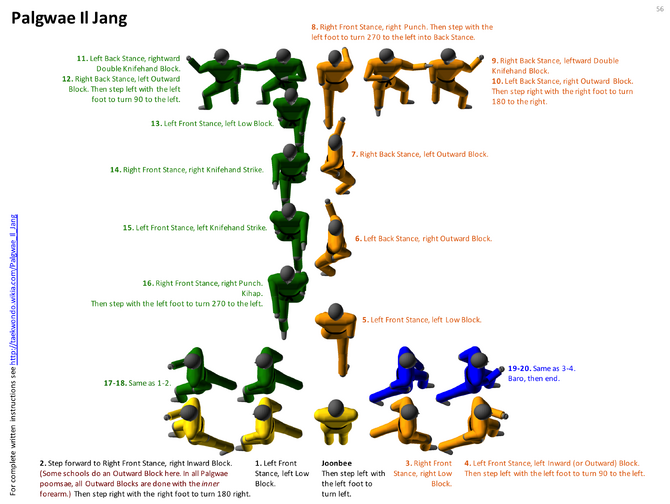Palgwae forms are an older set of poomsae (forms) originally used by the Korean Taekwondo Association in the late 1960s. In the early 1970s these were replaced by the modern taegeuk forms that are still in use in Kukkiwon/WTF-style taekwondo for all color belts (belts below black).
The palgwae forms are:
- Palgwae Il Jang
- Palgwae Yi Jang also spelled Palgwae Ee Jang
- Palgwae Sam Jang also spelled Palgwae Sahm Jang
- Palgwae Sa Jang also spelled Palgwae Sah Jang
- Palgwae Oh Jang also spelled Palgwae O Jang
- Palgwae Yook Jang also spelled Palgwae Yuk Jang
- Palgwae Chil Jang
- Palgwae Pal Jang also spelled Palgwae Phal Jang
Video[]
Why was this video chosen for use on this wiki? Do you have a better video? Please see Video Guidelines before replacing this video with a better one.
Note that in this version, the first line is being performed with Inward Blocks (as is more common) rather than Outward Blocks (as is seen in some schools).
Step-by-step video:
Diagram[]
To print the diagram, click on the image and select "See full size image," or right-click and open the image in a new tab.
Written Instructions[]
- Begin from the ready stance (junbi seogi).
- 1. Move the left foot to turn 90 left into Left Front Stance (wen apkubi) and execute a Left Low Block (i.e., downward block, arae makgi).
- 2. Step forward with the right foot into Right Front Stance (oreun apkubi) and execute a Right Inward Block (momtong makgi). (Some schools do an Inner-Forearm Outside Block; i.e., outward block with the inner-forearm).
- 3. Step right with the right foot to turn 180 degrees clockwise into Right Front Stance (oreun apkubi) and execute a Right Low Block (i.e., downward block, arae makgi).
- 4. Step forward with the left foot into Left Front Stance (wen apkubi) and execute a Left Inward Block (momtong makgi) (Or depending on the school, Inner-Forearm Outside Block).
- 5. Step with the left foot to turn left 90 degrees into Left Front Stance (wen apkubi) and execute a Left Low Block (i.e., downward block, arae makgi).
- 6. Moving the right foot, step forward into Left Back Stance (i.e., right foot forward, wen dwitkubi) and execute a Right Inner-Forearm Outward Side Block (i.e., palm-up with the right arm, to the side of the body, momtong yop makgi).
- 7. Moving the left foot, step forward into Right Back Stance (i.e., left foot forward, oreun dwitkubi) and execute a Left Inner-Forearm Outward Side Block (i.e., palm-up, momtong yop makgi).
- 8. Step forward with the right foot into Right Front Stance (oreun apkubi) and execute a Right Punch (momtong bandae jireugi). Kihap.
- 9. Step way back with the left foot to turn 270 counterclockwise into Right Back Stance (i.e., left foot forward, oreun dwitkubi) and execute a Double Knifehand Block (sonnal momtong makgi).
- 10. Stepping forward with the right foot into Left Back Stance (i.e., right foot forward, wen dwitkubi), execute a Right Inner-Forearm Outward Side Block (i.e., palm-up, momtong yop makgi).
- 11. Step right with the right foot to turn 180 clockwise into Left Back Stance (i.e., right foot forward, wen dwitkubi) and execute a Double Knifehand Block (sonnal momtong makgi).
- 12. Stepping forward with the left foot into Right Back Stance (i.e., left foot forward, oreun dwitkubi), execute a Left Inner-Forearm Outward Side Block (i.e., palm-up, momtong yop makgi).
- 13. Step left with the left foot to turn 90 counterclockwise into Left Front Stance (wen apkubi). Execute a Left Low Block (i.e., downward block, arae makgi).
- 14. Step forward into Right Front Stance (oreun apkubi) and execute a Right Inward Knifehand Neck Strike (sonnal mok chigii).
- 15. Step forward into Left Front Stance (wen apkubi) and execute a Left Inward Knifehand Neck Strike (sonnal mok chigii).
- 16. Step forward into Right Front Stance (oreun apkubi) and execute a Right Punch (momtong bandae jireugi). Kihap.
- 17. Step way back with the left foot to turn 270 counterclockwise into Left Front Stance (wen apkubi) and execute a Left Low Block (i.e., downward block, arae makgi).
- 18. Step forward with the right foot into Right Front Stance (oreun apkubi) and execute a Right Inner-Forearm Outside Block (i.e., inward block, momtong makgi)..
- 19. Step right with the right foot to turn 180 clockwise to the rear into Right Front Stance (oreun apkubi) and execute a Right Low Block (i.e., downward block, arae makgi).
- 20. Step forward with the left foot into Left Front Stance (wen apkubi) and execute a Left Inner-Forearm Outside Block (i.e., inward block, momtong makgi).
- Moving the left foot, return to ready stance. If you did everything right, you should wind up back where you started.


